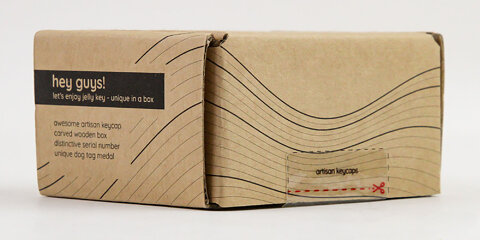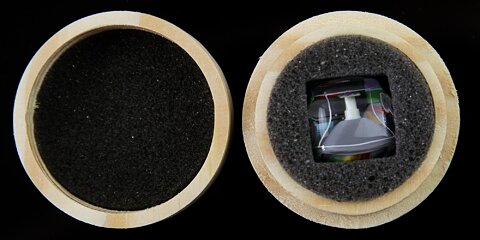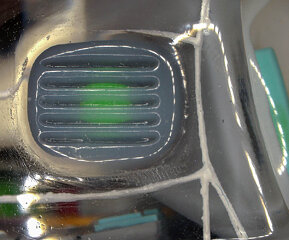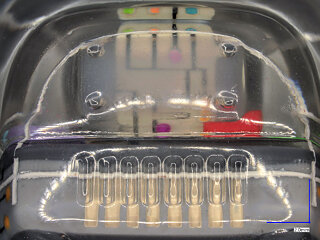 6
6
Quick Look: Jelly Key Retro TV + Dragons of Eden Artisan Keycaps
(6 Comments) »Introduction

Soon after my article covering a set of two Jelly Key artisan keycaps was published, the company got in touch to see if I would be interested in taking a look at a then-upcoming group buy artisan keycap. No thanks to shipping logistics, it arrived later than I wanted, with the group buy already over. I was then going to do a quick-look article of the same for their next group buy, and somehow exactly the same thing happened once more! This time, I felt bad enough to where we made a news post on the same, but then both keycaps arrived, so here we are doing a two-for-one quick look at two new Jelly Key artisans! Thanks again to the company for providing these demo samples to TechPowerUp.

The first to arrive is a member of the Retro TV series - Life on Planets theme, which aims to mimic a retro-style TV with different frame and screen designs in addition to larger versions that are more a cool desk toy than a keycap. This was followed by the latest Jelly Key theme—the so-called Dragons of Eden: East Sea's Guardians. Both are quite different in design from each other and the first two we covered already. Let's take a look at both in more detail now, noting that the time to buy them from the company has already passed. That said, both keycaps will likely be available for sale or resale through other hands sooner than later.
Retro TV series - Life on Planets
In some ways, I was glad to see this box because I immediately knew that a 1u-sized keycap would be inside. I covered in more detail before how Jelly Key spent more time on the actual packaging design than many companies spend on entire keyboards, and I had already seen the other two sizes of the solid paper boxes that use fully recycled materials. The box has the Jelly Key logo on front, with a list of contents inside on the side, along with a seal with contact information. Opening the packaging reveals the actual product box held in place by a shaped compartment in the solid paper packaging, and we then get a small wooden box with a rounded smooth finish. The hand-applied seal is a nice touch, and a marketing tagline is etched into the back. The box opens up to reveal the keycap, presented like a gift. There is foam lining on the lid, with the actual keycap inside a thicker foam piece with a cutout to snugly host the product. If you order more 1u keycaps, they will ship together in a larger box, but with a different foam piece and dividers between them.
We now get to the keycap itself, which is one of several possible combinations from the theme. The Retro TV series heralds a time when most of us weren't even around, but we can still relate to it courtesy media from the time. Think USA in the 60s, with an optimistic outlook towards life and imagination running free. There were things on television from other regions kids could watch and get inspired by, with the moon landing in particular resulting in a lot of interest in the possibility of extraterrestrial life. This group buy focused on 1u keycaps for keyboards only, which makes sense considering the design. This is the third entry in the Retro TV series, although the first two were both arcade cabinets, not TVs. The first one was a whole different form factor, but you can see where the second set is much closer to what we have now.
This is effectively a tiny retro-style TV design, which could be bought in a variety of different TV designs and TV screens as seen above. Resulting in a whopping 90 combinations, it was a somewhat modular design that is still shaped differently from your typical keycaps. There is a video which shows the various options in more detail. I have here the Steel Telly TV design with the Milky Way Greetings screen, and the two come together in a different way from typical artisan keycaps. As before, there are small parts, but then everything has to be cast separately and placed into a fitting geometry inside a TV case as opposed to a mold with resin poured over. A second TV case goes over this and the screen itself, making for the blurred optics and see-through finish that were all the rage a few years ago. The curved finish is also done by hand, so these likely took much longer to make as well, which is confirmed by the more detailed description of the creation process on the product page.
Here, we see the keycap installed, and it conforms to the standard Cherry MX stem compatibility even if it can get tight with spacing. Some non-traditional layouts may not like this as much, and this is a practical reason for only going the 1u route even if the TV design itself makes no sense when stretched. The obvious choice here was the Esc key, one that isn't accessed quite often and allows for a statement to be made with the artisan keycap towering over the rest. The contact area across the top is large enough to be functional, and don't worry about having to baby the keycap in use, either.
Like last time, I took the keycap to my lab and used my digital microscope for some extreme close-up photos. There's not much to see here given the light reflection and refraction, but we do see a higher-quality finish compared to typical resin-cast keycaps, especially for the intricate TV circuitry, if you will. The Jelly Key logo on the bottom is also well applied, as is the metal stamp that will have the serial number for a retail unit. The keycap walls are not uniform here, but they are still much thicker than average, coming in at 1.8–2.0 mm at the bottom, where we get a better look at the multiple layers involved.
Our Patreon Silver Supporters can read articles in single-page format.
Apr 25th, 2024 00:48 EDT
change timezone
Latest GPU Drivers
New Forum Posts
- What's your latest tech purchase? (20337)
- The Official Linux/Unix Desktop Screenshots Megathread (694)
- XFX RX470 8GB no video and error 43 (27)
- (Anti) SFF fun house (348)
- Cinebench crashed my PC. My Wi-Fi stopped working, and I keep getting a "Please wait" screen when I boot up my PC. (31)
- im new to throttelstop and i think i messed it up by copying others any hints would be very much aprreciated (1)
- Aida64 cache mem OC (7)
- I am getting artifacting when I change Windows security settings. Is my GPU failing, or is this just a Windows issue? (10)
- Is there a technical reason that Windows 11 doesn't have built into it battery charge limitation? (42)
- The TPU UK Clubhouse (24783)
Popular Reviews
- Fractal Design Terra Review
- Thermalright Phantom Spirit 120 EVO Review
- Corsair 2000D Airflow Review
- Minisforum EliteMini UM780 XTX (AMD Ryzen 7 7840HS) Review
- ASUS GeForce RTX 4090 STRIX OC Review
- NVIDIA GeForce RTX 4090 Founders Edition Review - Impressive Performance
- ASUS GeForce RTX 4090 Matrix Platinum Review - The RTX 4090 Ti
- MSI GeForce RTX 4090 Suprim X Review
- MSI GeForce RTX 4090 Gaming X Trio Review
- Gigabyte GeForce RTX 4090 Gaming OC Review
Controversial News Posts
- Sony PlayStation 5 Pro Specifications Confirmed, Console Arrives Before Holidays (116)
- NVIDIA Points Intel Raptor Lake CPU Users to Get Help from Intel Amid System Instability Issues (106)
- AMD "Strix Halo" Zen 5 Mobile Processor Pictured: Chiplet-based, Uses 256-bit LPDDR5X (101)
- US Government Wants Nuclear Plants to Offload AI Data Center Expansion (98)
- Windows 10 Security Updates to Cost $61 After 2025, $427 by 2028 (84)
- Developers of Outpost Infinity Siege Recommend Underclocking i9-13900K and i9-14900K for Stability on Machines with RTX 4090 (84)
- TechPowerUp Hiring: Reviewers Wanted for Motherboards, Laptops, Gaming Handhelds and Prebuilt Desktops (78)
- AMD's RDNA 4 GPUs Could Stick with 18 Gbps GDDR6 Memory (74)





















